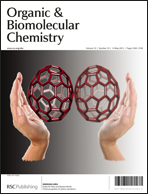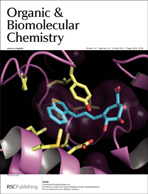We are pleased to present to you OBC issue 18, 2012
 Emilio M. Pérez and Nazario Martín present an Emerging area article providing an overview of some of the few successful examples of chiral recognition of carbon nanoforms, highlighting their common features with the aim of helping to develop general trends for the design of new generations of hosts.
Emilio M. Pérez and Nazario Martín present an Emerging area article providing an overview of some of the few successful examples of chiral recognition of carbon nanoforms, highlighting their common features with the aim of helping to develop general trends for the design of new generations of hosts.
Chiral recognition of carbon nanoforms
Emilio M. Pérez and Nazario Martín
Org. Biomol. Chem., 2012, 10, 3577–3583
DOI: 10.1039/C2OB07159B
 The inside front cover illustrates work by Concepción González-Bello and co-workers at Universidad de Santiago de Compostela and University of Newcastle upon Tyne, who synthesised several 3-alkylaryl mimics of the enol intermediate in the the reversible dehydration reaction of 3-dehydroquinic acid, which is catalysed by type II dehydroquinase, to investigate the effect on the inhibition potency of replacing the oxygen atom in the side chain by a carbon atom.
The inside front cover illustrates work by Concepción González-Bello and co-workers at Universidad de Santiago de Compostela and University of Newcastle upon Tyne, who synthesised several 3-alkylaryl mimics of the enol intermediate in the the reversible dehydration reaction of 3-dehydroquinic acid, which is catalysed by type II dehydroquinase, to investigate the effect on the inhibition potency of replacing the oxygen atom in the side chain by a carbon atom.
Synthesis of 3-alkyl enol mimics inhibitors of type II dehydroquinase: factors influencing their inhibition potency
Beatriz Blanco, Antía Sedes, Antonio Peón, Heather Lamb, Alastair R. Hawkins, Luis Castedo and Concepción González-Bello
Org. Biomol. Chem., 2012, 10, 3662–3676
DOI: 10.1039/C2OB07081B
| Both of these articles are free to access for 6 weeks so get your hands on them today! |
Also in this issue:
A perspective by María Paz Muñoz covering the progress in transition metal-catalysed intermolecular reaction of allenes with oxygen nucleophiles, analysing the intermolecular metal-catalysed reaction of allenes using palladium, iridium, rhodium, ruthenium, gold and platinum, in the presence of alcohols, water or carboxylic acids, and the mechanistic implications of these processes depending on the metal used.
Transition metal-catalysed intermolecular reaction of allenes with oxygen nucleophiles: a perspective María Paz Muñoz
Org. Biomol. Chem., 2012,
DOI: 10.1039/C2OB07128B
The HOT article :
A convenient biomimetic synthesis of optically active putative neurotoxic metabolites of MDMA (“ecstasy”) from R-(−)- and S-(+)-N-methyl-α-methyldopamine precursors
Claire-Marie Martinez, Anne Neudörffer and Martine Largeron
DOI: 10.1039/C2OB25245G










